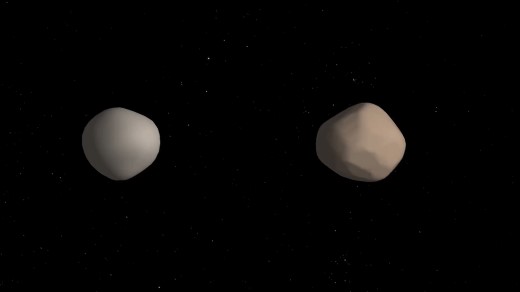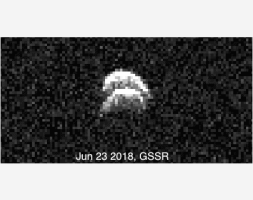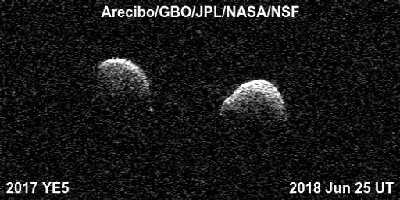We learned late last week that the near-Earth asteroid 2017 YE5, discovered just last December, is what is described as an ‘equal mass’ binary. This would make it the fourth near-Earth asteroid binary ever detected in which the two objects are nearly identical in size, both about 900 meters. The binary’s closest approach to Earth was on June 21, 2017, when it came to within 6 million kilometers, some 16 times the distance between the Earth and the Moon. It won’t be that close again for at least another 170 years.

Image: Artist’s concept of what binary asteroid 2017 YE5 might look like. The two objects show striking differences in radar reflectivity, which could indicate that they have different surface properties. Credit: NASA/JPL-Caltech.
What you have above is an artist’s impression of how 2017 YE5 appears, but have a look at the radar imagery below. This comes from NASA’s Goldstone Solar System Radar (GSSR, observations conducted on June 23, 2018), and shows the presence of two lobes. We don’t yet see a binary, but these radar images were enough for Goldstone scientists to alert astronomers at Arecibo Observatory, who had already inserted 2017 YE5 into their observing list.

Image: Radar images of the binary asteroid 2017 YE5 from NASA’s Goldstone Solar System Radar (GSSR). The observations, conducted on June 23, 2018, show two lobes, but do not yet show two separate objects. Credit: NASA/JPL-Caltech/GSSR.
Working with researchers at the Green Bank Observatory in West Virginia, the Arecibo scientists linked the two observatories in a bi-static radar configuration, meaning that Arecibo transmits the radar signal while Green Bank receives the return signal. It was the combination of data from the two observatories that allowed 2017 YE5 to be confirmed as two separated objects.

Image: Bi-static radar images of the binary asteroid 2017 YE5 from the Arecibo Observatory and the Green Bank Observatory on June 25. The observations show that the asteroid consists of two separate objects in orbit around each other. Credit: Arecibo/GBO/NSF/NASA/JPL-Caltech.
A surprising number of near-Earth asteroids may be binaries, according to this JPL news release, which tells us that among near-Earth asteroids larger than 200 meters in size, about 15 percent are binaries with one larger object and a much smaller asteroid satellite. While equal-mass binaries are apparently rare, contact binaries (two equally sized objects in contact with each other) make up another 15 percent of the population in this size range.
Thus at 2017 YE5 we have two objects that revolve around each other every 20 to 24 hours, as confirmed through brightness variations at visible light wavelengths at the Center for Solar System Studies in Rancho Cucamonga, California. As to composition, the two components do not reflect as much sunlight as a typical rocky asteroid, making it likely that 2017 YE5 has a surface as dark as charcoal. Differences in reflectivity of the two objects suggest that they have different composition at the surface or perhaps different surface features.
I was startled to learn that more than 50 binary asteroid systems have turned up in radar studies since 2000, with the majority consisting of one large object and a much smaller satellite. The differences in radar reflectivity found at 2017 YE5 have not appeared in this population. That makes this binary a useful system for the study of binary formation. Further study of combined radar and optical observations may allow tighter constraints on the density of the 2017 YE5 objects, which should give us a window into their composition and structure.



The last frame in the Bi-static radar Gif image looks like an electrical discharge is going from the binary on the left to the one on the right. Probably just a artifact, but have seen images from other asteroids by radar that have been inproved greatly by image processing. What would a probe look like after being in interstellar then a planetary environment for thousands of years? That would be an interesting challenge for NASA since thay have so much data on the long term effects on spacecraft in space. Would they also turn black from radiation, charged particles and dust impacts?
Is this binary pair likely to have formed through the accretion of dust from a protopanetary disc or from fragments from collisions of larger bodies?
Remember asteroid BZ509? The one with the retrograde orbit among all of the prograde ones? Well, a similar situation presents itself around Jupiter of all places! Twelve new moons have been recently discovered. making the total 79. Two are prograde moons among the prograde group orbiting just outside the Galileans. Nine new retrograde moons have been discovered among the retrograde group, much farther from Jupiter than the prograde group. HOWEVER; the 12’th moon has a prograde orbit, but is situated among the RETROGRADE GROUP, on an orbit, that according to the discoverers, MUST EVENTUALLY IMPACT ONE(non-specific as to which)of the retrograde ones at some unspecified time!!!!! The discoverers believe that this moon was formed RECENTLY(astronomically speaking) as a result of a collision between either two retrograde moons, or more likeky, between a retrograde moon and a comet or asteroid, greatly increasing its chances of its orbit being prograde. What’s really weird is that it is BY FAR the smallest moon ever discovered around Jupiter, LESS than one kilometer in diameter. Because it is so small, its composition cannot be determaied by ANY CURRENT TELESCOPE,space or ground. It will have to wait for ELT or the NEW Magellan telescopes to come online. But, in the extremely unlikeky scenario that this is NOT NATURAL(i.e. a Bracewell probe). HST or Spitzer could monitor it to see if it CHANGES its orbit to AVOID all of the other retrograde moons!
Somebody help me out please! I have been literally TROLLING the internet for the paper so that I can read the PDF! NO LUCK! All that I have found out is that the lead author of the paper is Scott Sheppard, who has previously discovered dozens of other moons orbiting Jupiter. The reason for my urgency in this matter is that, looking at the ILLUSTRATION of the orbits of the new moons, the interesting one(PROVISIONALLY named Valetupo)has an orbit that to my VERY AMETEUR EYE(in astronomer terms) looks PREFECTLY CIRCULAR!!!!! There is not ONE captured moon of Jupiter or any other outer planet that has an orbit even CLOSE to being circular! ALSO: I assume Sheppard et al are basing the objects radius on an albedo CONSISTENT with the albedos of previously discovered moons(assumed to be VERY LOW). If this object does turn out to INDEED have a circular orbit AND a high albedo, than it may be more of a BEACON(HEY! LOOK AT ME! I am very very VERY WEIRD!!!!!)than a Bracewell probe!
some info here including orbits. “Veletudo” is the name they gave it.
https://carnegiescience.edu/news/dozen-new-moons-jupiter-discovered-including-one-“oddball”
https://sites.google.com/carnegiescience.edu/sheppard/moons/jupitermoons
Perhaps Mr. Sheppard and his team is still working on the paper as this was only announced on July 16
In the past, I have wondered about a flyby rotorvator made of an asteroid bola. My thought was to use cables to slice a rotating nickel/iron slug (Kursk-style) into two parts and have it form a bola.
This would be a backspun flyby rotovator where one whole chunk would be deposited at near zero speed, and a tether then jerking a huge mass into space once the asteroid bit is released–a giant Skyhook for the largest payloads
Try here https://sites.google.com/carnegiescience.edu/sheppard/moons/jupitermoons
has orbital parameters including of “Valetudo”
https://arxiv.org/abs/1705.00683
All planetesimals born near the Kuiper Belt formed as binaries
Wesley C. Fraser, Michele t. Bannister, Rosemary E. Pike, Michael Marsset, Megan E. Schwamb, J. J. Kavelaars, Pedro Lacerda, David Nesvornyy, Kathryn Volk, audrey Delsanti, Susan Benecchi, Matthew J. Lehner, Keith Noll, Brett Gladman, Jean-Marc Petit, Stephen Gwyn, Ying-tung Chen, Shiang-Yu Wang, Mike Alexandersen, Todd Burdullis, Scott Sheppard, Chad Trujillo
(Submitted on 1 May 2017)
The cold classical Kuiper belt objects have low inclinations and eccentricities and are the only Kuiper belt population suspected to have formed in situ. Compared with the dynamically excited populations, which exhibit a broad range of colours and a low binary fraction of ~10% cold classical Kuiper belt objects typically have red optical colours with ~30% of the population found in binary pairs; the origin of these differences remains unclear.
We report the detection of a population of blue-coloured, tenuously bound binaries residing among the cold classical Kuiper belt objects. Here we show that widely separated binaries could have survived push-out into the cold classical region during the early phases of Neptune’s migration. The blue binaries may be contaminants, originating at ~38 au, and could provide a unique probe of the formative conditions in a region now nearly devoid of objects.
The idea that the blue objects, which are predominantly binary, are the products of push-out requires that the planetesimals formed entirely as multiples.
Plausible formation routes include planetesimal formation via pebble accretion and subsequent binary production through dynamic friction and binary formation during the collapse of a cloud of solids.
Comments: 7 Figures, 3 tables, accepted to Nature Astronomy. Main manuscript and supplement available at this http URL
Subjects: Earth and Planetary Astrophysics (astro-ph.EP)
DOI: 10.1038/s41550-017-0088
Cite as: arXiv:1705.00683 [astro-ph.EP]
(or arXiv:1705.00683v1 [astro-ph.EP] for this version)
Submission history
From: Wesley C. Fraser [view email]
[v1] Mon, 1 May 2017 19:49:01 GMT (2686kb,D)
https://arxiv.org/pdf/1705.00683.pdf
I’ve always wondered how to interpret these radar images. What’s actually going on to make them always look like crescents? Is this due to the processing, or what?
http://www.planetary.org/blogs/emily-lakdawalla/2010/2462.html